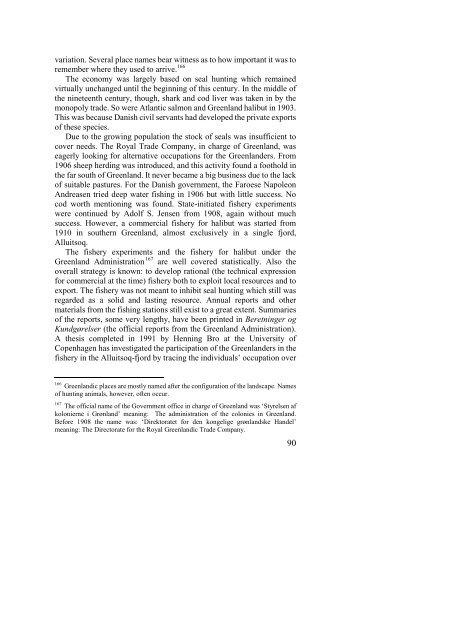The North Atlantic Fisheries, 1100-1976 - University of Hull
The North Atlantic Fisheries, 1100-1976 - University of Hull
The North Atlantic Fisheries, 1100-1976 - University of Hull
You also want an ePaper? Increase the reach of your titles
YUMPU automatically turns print PDFs into web optimized ePapers that Google loves.
variation. Several place names bear witness as to how important it was to<br />
remember where they used to arrive. 166<br />
<strong>The</strong> economy was largely based on seal hunting which remained<br />
virtually unchanged until the beginning <strong>of</strong> this century. In the middle <strong>of</strong><br />
the nineteenth century, though, shark and cod liver was taken in by the<br />
monopoly trade. So were <strong>Atlantic</strong> salmon and Greenland halibut in 1903.<br />
This was because Danish civil servants had developed the private exports<br />
<strong>of</strong> these species.<br />
Due to the growing population the stock <strong>of</strong> seals was insufficient to<br />
cover needs. <strong>The</strong> Royal Trade Company, in charge <strong>of</strong> Greenland, was<br />
eagerly looking for alternative occupations for the Greenlanders. From<br />
1906 sheep herding was introduced, and this activity found a foothold in<br />
the far south <strong>of</strong> Greenland. It never became a big business due to the lack<br />
<strong>of</strong> suitable pastures. For the Danish government, the Faroese Napoleon<br />
Andreasen tried deep water fishing in 1906 but with little success. No<br />
cod worth mentioning was found. State-initiated fishery experiments<br />
were continued by Adolf S. Jensen from 1908, again without much<br />
success. However, a commercial fishery for halibut was started from<br />
1910 in southern Greenland, almost exclusively in a single fjord,<br />
Alluitsoq.<br />
<strong>The</strong> fishery experiments and the fishery for halibut under the<br />
Greenland Administration 167 are well covered statistically. Also the<br />
overall strategy is known: to develop rational (the technical expression<br />
for commercial at the time) fishery both to exploit local resources and to<br />
export. <strong>The</strong> fishery was not meant to inhibit seal hunting which still was<br />
regarded as a solid and lasting resource. Annual reports and other<br />
materials from the fishing stations still exist to a great extent. Summaries<br />
<strong>of</strong> the reports, some very lengthy, have been printed in Beretninger og<br />
Kundgørelser (the <strong>of</strong>ficial reports from the Greenland Administration).<br />
A thesis completed in 1991 by Henning Bro at the <strong>University</strong> <strong>of</strong><br />
Copenhagen has investigated the participation <strong>of</strong> the Greenlanders in the<br />
fishery in the Alluitsoq-fjord by tracing the individuals’ occupation over<br />
166 Greenlandic places are mostly named after the configuration <strong>of</strong> the landscape. Names<br />
<strong>of</strong> hunting animals, however, <strong>of</strong>ten occur.<br />
167 <strong>The</strong> <strong>of</strong>ficial name <strong>of</strong> the Government <strong>of</strong>fice in charge <strong>of</strong> Greenland was ‘Styrelsen af<br />
kolonierne i Grønland’ meaning: <strong>The</strong> administration <strong>of</strong> the colonies in Greenland.<br />
Before 1908 the name was: ‘Direktoratet for den kongelige grønlandske Handel’<br />
meaning: <strong>The</strong> Directorate for the Royal Greenlandic Trade Company.<br />
90















